The Great Ocean Road Melbourne is one of the Worlds most scenic driving routes. It’s just over an hours journey from the city and its the perfect self drive Melbourne Road trip. If you don’t wish to organise a Great Ocean Road itinerary, and you’re concerned about the amount of driving yourself, don’t worry, you can take a Great Ocean Road Tour from Melbourne.
This post includes a suggested itinerary for a
1-day Great Ocean Road tour,
Great Ocean Road 2 day tour
Great Ocean road 3 days itinerary
This article may contain compensated links. Please read my disclaimer policy for more info.
You’ll also find a comprehensive guide explaining what to see on the Great ocean road, information about Great ocean road accommodation, popular walks and driving times.
Timings in the itineraries below are only suggestions as traffic, the weather and time spent at Great Ocean road stops can all vary.
You’ll find full descriptions of Great Ocean towns and activities in the things to do section.
You can also use the information in this post as a Great Ocean Road trip planner to compile a unique itinerary.
Great Ocean Road itinerary 1 day
This itinerary takes in the best Great Ocean Road Stops and Great Ocean Road Highlights.
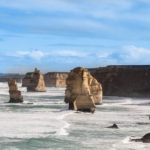
6.30 am -Drive from Melbourne straight to the 12 apostles via the M1 motorway. It’ll take you the best part of 3 hours to get there, but you can then gradually make your way back to the city. If you start at the Apostles Great Ocean Road, you’ll be ahead of the crowds as most people do it in the other direction.

10.30 am – Having had a quick snack in the cafe at the visitor’s centre, drive towards Warrnambool and take in the sites of Loch Ard Gorge, London Bridge, and the Grotto.
11.30 am – Drive to Apollo Bay which will take around 1 hour 40 minutes
1.15 pm– Stop for lunch in Apollo Bay and take a stroll along the Beach 
2.45 pm – Head to Kennett River to see the Wild Koalas. It will take you approximately 30 minutes to drive here from Apollo Bay.
3.15 pm -Head back to Melbourne along the Great Ocean Road and pick up the M1 motorway at Torquay.
A Great Ocean Road, 1-day tour, means a tight schedule with a lot of time spent behind the wheel. Timings are approximate as it depends on traffic and how long you spend at the Great Ocean Road sights. However, it does mean that you get to see the best bits of the Great Ocean Road in one day.
Tips for a Great Ocean Road Itinerary 1 day
Pick up the car as late as possible the day before your Great Ocean Road day trip. That way you can either head off straight away in the morning or get a head start by staying the night at Port Campbell.
Be organised – Plan what you want to see in advance of your visit.
Take a packed lunch and snacks for the journey; there’s plenty of fabulous picnic spots along the Ocean Road.
If you don’t fancy all that driving and only have one day consider booking a Great Ocean Road Tour.
Great Ocean Road itinerary 2 days
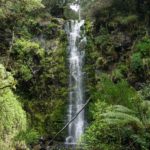 7.30 am -Pick up a hire car in Melbourne and set off to Torquay at the start of the Great Ocean Road.
7.30 am -Pick up a hire car in Melbourne and set off to Torquay at the start of the Great Ocean Road.
9.30 am – Arrive at Bells Beach and stretch your legs.
10.00 am -Drive to Lorne and take a walk at Erskine Falls then enjoy lunch, before heading to Teddys Lookout
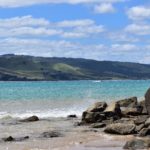 3.00 pm– Continue along the Great Ocean Road till you reach the Kennett River and go in search of wild koalas
3.00 pm– Continue along the Great Ocean Road till you reach the Kennett River and go in search of wild koalas
4.00pm – Head to Apollo Bay and enjoy a walk either along the beach or at Maits Rainforest before going to Mariner’s Lookout to watch the sunset. If you don’t mind getting up early, it’s even more stunning at sunrise.
Spend the night at the Comfort Inn near the Apollo Bay Golf Club.
Day 2
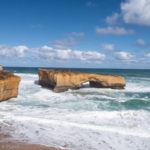 9.00am – After breakfast drive to the Ottway Lighthouse and take a self-guided tour before driving to the Gibson Steps.
9.00am – After breakfast drive to the Ottway Lighthouse and take a self-guided tour before driving to the Gibson Steps.
11.00 am– Enjoy a walk at Gibson Steps before heading to the Twelve Apostles
12.00 noon-Twelve Apostles enjoy some time admiring the magnificent sea stacks, before lunch in the cafe
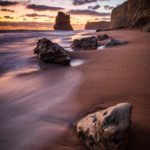 2.00 pm -Head to Loch Ard George and enjoy a walk as well as the Gorge
2.00 pm -Head to Loch Ard George and enjoy a walk as well as the Gorge
3.30 pm Drive to London Bridge and the Grotto before returning to watch the sunset over the 12 Apostles
Make your way back to Melbourne via the inland road. You can stop in Colac for an evening meal on the route.
Great Ocean Road itinerary 3 days
Day 1
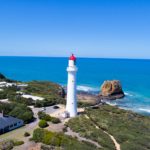
Spend day one between Torquay and Apollo Bay take in in a few walks, or maybe a horse ride along the way. Get an early start and head to Torquay where you can stretch your legs by doing a section of the Bells Track Walk.
Get back in the car and drive to Anglesea for morning coffee and maybe a stroll down the river. Before arriving in Lorne for lunch stop at Airey’s inlet for a look around the lighthouse or a take a horse ride along the beach.

In the afternoon take in Erskine Falls and Teddy’s Lookout before going on the hunt for wild Koalas at Kennett River. End the day watching the sun go down at Mariner’s lookout and enjoying a meal before checking into the Apollo Bay Comfort Inn.
Day 2
Start the day back at Mariners Lookout, watching the sunrise and then enjoy breakfast before admiring the local artwork on the 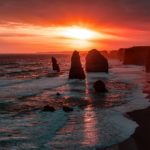 sculpture trail. You could then spend some time relaxing on the beach before sampling the delights of Otway National Park on the Maits rainforest walk.
sculpture trail. You could then spend some time relaxing on the beach before sampling the delights of Otway National Park on the Maits rainforest walk.
In the afternoon take in a history talk at Cape Otway lighthouse before driving to the Gibson Steps, end the day by watching the sun go down at the 12 apostles.
You can spend the night at Clifton Beach Lodge or in Port Campbell if you prefer to be in a town.
Day 3
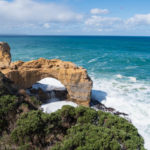 Start by watching the sunrise at the 12 apostles and perhaps take a helicopter ride over these amazing sea stacks. Enjoy your time at the Apostles before going on to see Loch Ard Gorge.
Start by watching the sunrise at the 12 apostles and perhaps take a helicopter ride over these amazing sea stacks. Enjoy your time at the Apostles before going on to see Loch Ard Gorge.
Explore the walks there before continuing onto the Arch, London Bridge and the Grotto.
If you’ve got time in the afternoon, you could continue onto Warrnambool and the Bay of Islands. Drive back to Melbourne along the inland route. The views of the hinterland are spectacular, and you can stop at Colac for dinner before you hit the motorway.
How to get to the Great Ocean Road
The easiest way to explore is by planning a Great Ocean Road self-drive itinerary. Having a car means that you can go at your own pace and stop at the attractions that you want to see.
Remember that cars drive on the left-hand side of the road in Australia and there are hefty penalties for breaking the speed limits.
Great Ocean Road Speed limit
The speed limit along the Great Ocean Road is 80km/h to 100km/h.
However, you are unlikely to reach such speeds as the volume of traffic is usually high and overtaking on most of the road is not safe.
It’s also the most spectacular route and with frequent stops and panoramic views to enjoy why would you want to rush. In the towns, you must reduce your speed limit to 50km/h
Getting around by car on a Great Ocean drive
Driving along the Great Ocean Road is a pleasant experience, yes there are a few twists and turns, but the road is tarmacked and well maintained.
All the significant sights have car parks, most of which are free. However, some of the car parks are small, so may find them busy in the summer months.
Great Ocean Road Bus
It is possible to explore the Great Ocean Road by bus. However, you need to plan your itinerary carefully as buses don’t run daily.
The V/Line bus runs along the route in both directions between Geelong and Warrnambool.
From Melbourne’s Southern Cross Railway Station there are frequent trains to Geelong.
Buses stop for approximately 15 minutes at the major sights along the Great Ocean Road, so you don’t get very long, but it is a cheap way to travel.
For more information on the bus route, you can download the timetable here.
Best Great Ocean Road Tour
The easiest way to explore the Great Ocean Road if you don’t want to hire a car is to join a tour.
In this next section, you’ll find information on the great ocean road towns and what attractions there is to see there. As travellers we all like different things and one hat certainly doesn’t fit all.
You can use the suggestions in the itineraries above or get some further inspiration from the information below.
You’ll also find my picks for the best accommodation at each town and information about relevant sections of the Surf Coast Walk.
Surf Coast Walk
Below each town, I’ve also listed the sections of the Surf Coast walk. For keen hikers, the Surf coast walk is a 44 km great ocean road walk that takes you from Torquay to Aireys Inlet. Its divided into 12 sections, which are graded by difficulty.
Of course, you don’t have to do all 12 sections you could do 1 or 2 or even just part of one. It’s a fabulous way to enjoy the coastal views and appreciate the real ambience of the Ocean Road.
Grade 1 trails have wide concrete paths and minimal gradient. These are suitable for everyone.
Grade 2 trails are flat and smooth and easy to walk along
Grade 3 trails have steeper inclines and involve stairs and walking along the beach.
Things to do Great Ocean Road
Torquay
Torquay is a surfers paradise and home to one of the best Great Ocean Road beaches, Bells Beach. Over the Easter weekend, you can watch the best surfers take to their boards in the Rip Curl Pro Surfing Competition.
The cliff tops that enclave the stunning beach provide a great backdrop, and the views are spectacular from the car park.
Surf Coast Walk sections 2 and 4
Torquay promenade – Yellow Bluff to Point Danger – Grade 1 trail
There’s a car park at yellow bluff which is along the Esplanade in Torquay the place where this walk starts. The path to Point Danger is 1.3 km and takes only 15 minutes to walk one way.
This is a lovely walk along the Esplanade that takes you past several local cafes and shops. It ends at the Point Danger Lookout where there is a local war memorial.
Bells Track Walk Bird Rock- Bells Beach-Grade 2 trail
From the car park follow the signs to the Bells Track walk which leads you along the cliff tops to Bird Rock.
It’s an easy 3km (one way) walk that provides breathtaking views across the bay and if the weather’s right you’ll see plenty of surfers along the stretch of the coast ‘that’s known as the “golden mile” of surfing.
Anglesea
Fifteen minutes from Torquay along this self-drive ocean road tour is the quaint town of Anglesea. It’s a great place to visit if you want to spend some time relaxing on the beach and swimming in the sea.
Anglesea has a wide golden sand beach that’s protected from the strong currents further along the coast by the Anglesea River.
There are some fantastic walks to enjoy either on the boardwalk by the river where you can hire a canoe or if you’re looking for something more unique, take the Anglesea Art walk. The 2.5 km walk passes six mosaic works which are inspired by ‘Anglesea’s history and nature. The trail begins at Loveridge lookout and ends at Anglesea Primary School. Along the way, you not only get to see the impressive artwork, but ‘you’ll see breathtaking views.
Surf coast walk sections 7 and 8
Anglesea Riverbanks -Grade 1 trail
An easy 1.6km trail that you can complete in 45 minute round trip. You can park by the Anglesea visitors centre and take a stroll along the boardwalks around the river. You’ll pass a few cafes, and there’s an opportunity to take a paddleboat or canoe ride if you fancy.
Point Roadknight – Anglesea to Point Roadknight – Grade 2 trail
For more spectacular views across the town, river and ocean enjoy a walk along the path to Roadknight beach. It will take you a couple of hours to complete the 3km walk both ways, but of course, you can relax on the beach before making the return journey.
Airey’s Inlet
A 10-minute drive is ‘Airey’s inlet, and the lighthouse here is another of the great ocean road sights worth visiting.
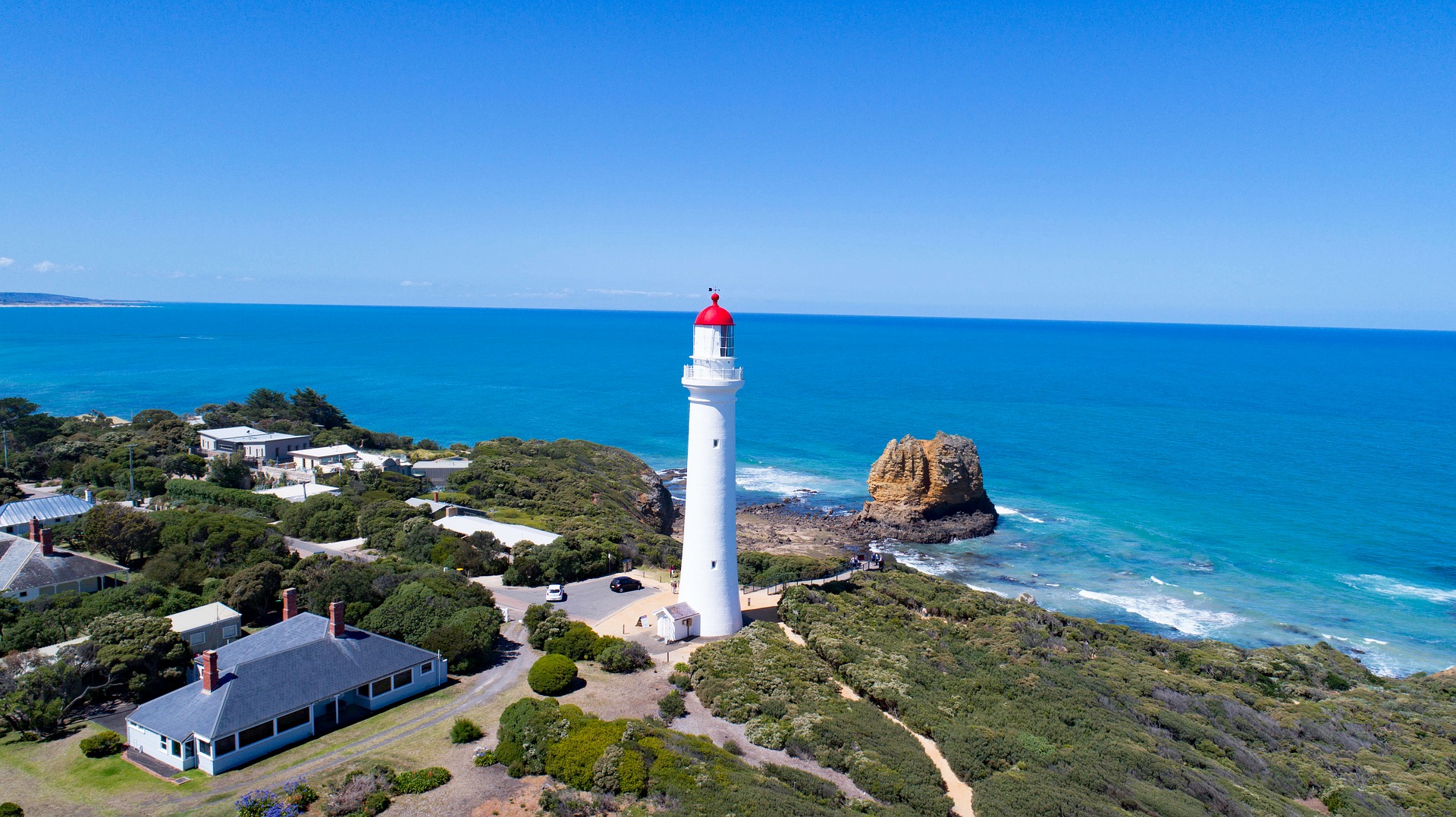
Split Point lighthouse has appeared on several television shows including MasterChef and Round the Twist. She’s known by locals as the White lady and is still in operation today.
You can take a self-guided tour of the lighthouse at the weekend and during the week guided tours take place on the hour between 11 am and 2 pm.
Prices are cheaper than the Otway Lighthouse, and you’ll find far fewer tourists visit here, so it’s a much better place to stop. You get spectacular views over the ocean and if you’re a photographer, the night sky is fabulous to capture with the lighthouse as your focal point. Such pictures are not possible to take at the Otway lighthouse.
There’s also a variety of outdoor activities that you can join in the area which include canoeing, golf, mountain biking and fishing.
Surf coast walk sections 11 and 12
Aireys Clifftops- Sunnymead to Aireys Lighthouse – Grade 2 trail
After visiting the lighthouse, stretch your legs by taking a glorious walk along the coast and through bushland to Sunnymead Beach. It will take you approximately 30 minutes to walk there along the narrow 2.8km trail.
Lighthouse Discovery – Aireys Lighthouse to Fairhaven – Grade 2 trail
From the lighthouse, you can also complete the final leg of this Great Ocean coastal walk. The 2km stretch is well signposted, and there are several stunning lookouts along the way.
You’ll also pass excellent whale watching spots, and there are informative displays along the Lighthouse discovery trail.
Horse riding Great Ocean Road
Airey Inlet is also the place to stay if you fancy experiencing the Great Ocean Road on horseback. Blazing Saddles runs tours for beginners to experienced riders through the beach and bushland around the area.
Lorne
Approximately 20 minutes further along the Great Ocean Road from Anglesea is Lorne. The natural wonders of Ottway national park are close by, and the picture-postcard town sits on the edge of Loutit bay.
It’s a popular stop on the many peoples Great Ocean Road trip and its another great place to spot whales during the season. There’s plenty of walks you can do from Lorne, but one of the most popular is to ‘Teddy’s Lookout.
Teddy’s Lookout
The view from Teddy’s lookout is stunning across the Bass Strait, especially when the sky is bright blue. To get there from the centre of Lorne drive to the top of George street and ‘you’ll see a picnic area and a car park. From here its a short walk to Teddy’s Lookout.
There’s a 1km walk here around a looped circuit which takes you through the bush to viewpoints over the Otway Ranges and the spectacular cost. The walk takes approximate 20 minutes and keeps your eyes peeled as you might spot a koala along the way.
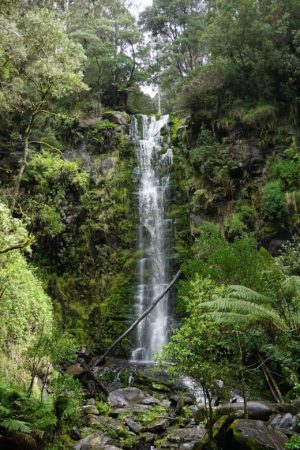
Another popular walk is to Erskine falls. There are over ten waterfalls within easy distance of Lorne, but the spectacular cascade at Erskine is what most people come to see.
Surrounded by a lush green oasis of ferns in the Otway National Park, the 30-metre drop of Erskine falls is magnificent.
The car park is at the top of Erskine falls road about 10km from Lorne and the Great Ocean Road.
There are two lookouts, the second of which involves a reasonably steep descent down some stairs, but the beautiful view of the cascading water into the lush fern surroundings below is worth the effort.
Kennett River
Everyone wants to see a koala when they visit Australia, and the Kennett River is one of the best places to spot wild Koalas on the Great Ocean Drive. Melbourne.zoo and Healesville sanctuary are alternatives in the city, but nothing beats seeing these cute animals in the wild.

The Kennett River is a 30-minute drive from Lorne and its easy to miss. Look out for a small car park and a coffee on the right-hand side of the road if your driving from Torquay towards Port Campell. This is Kennett river, basically, a road that goes up the hill from the car park and its surround by gum trees.
If you’re lucky you’ll coincide your visit with the Great Ocean Road tour buses and you’ll know if there’s a koala by the reaction of the crowds. Don’t worry, tour groups don’t tend to stay long, and soon you’ll have the place to yourselves.
The Koalas are usually asleep for most of the day, and the best time to see them is around mid-afternoon till sunset. Don’t forget to bring a good zoom lens if you want to get close up photographs.
Mariners Lookout
Just before you reach Apollo Bay, you can turn off the Great Ocean Road and drive up the hill to the Marriners Lookout.
From the car park its approximately a 10-minute walk to the viewpoint where you get amazing views on the surrounding area, the town, beach and of course the ocean.
Apollo Bay
Apollo Bay is an excellent place to stay on your Great Ocean Road Drive from Melbourne and its approximately 30 minutes from the Kennet River.
It makes the perfect base for exploring the natural beauty of Cape Otway National Park, and there are some excellent restaurants in the centre.
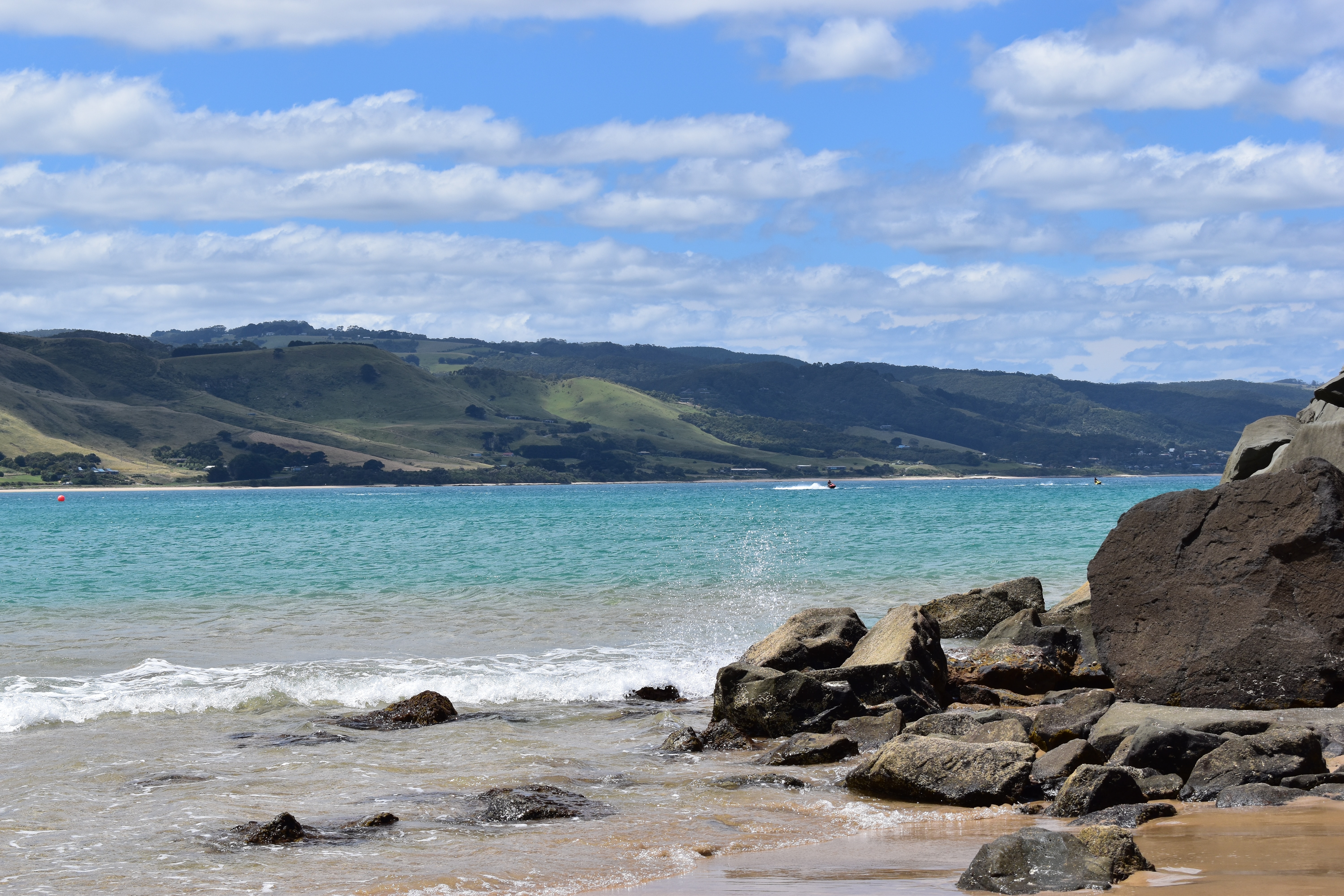
Apollo Beach Bay
The beach is beautiful with its golden sand and perfect for building sandcastles, swimming in the sea or taking a stroll along. The harbour protects the bay making the water suitable for casual swimming, and lifeguards patrol the beach during the summer months.
Sculpture Walk
This short 1.5km walk begins at the visitor’s centre at takes around 20 minutes to complete. Along the trail ‘there’s an array of wooden sculptures by local artists which are one of the town’s highlights.
Maits Rest Rainforest Walk
If you haven’t got time to explore venture into Otway National Park this walk is an excellent introduction to the rainforest.
It’s only a 15-minute drive inland from Apollo Bay to the start of the trail, and you can complete the 1km circuit in 30 minutes.
The walk takes you past some enormous trees, some of which are at least 300 years old. The boardwalk makes the route easily accessible, and if you keep your eyes open, you may spot a koala or a kangaroo along the way.
Cape Otway Lighthouse
Australias oldest lighthouse has been sitting since 1848 on this stretch of rugged coastline which people nickname the shipwreck coast. The 90-metre high lighthouse sits proudly on the top of the cliffs, and the view from the balcony is stunning.
On a visit here you can learn about the history of the shipwrecks, discover the role of the lighthouse in WWII and enjoy homemade scones in the cafe. https://www.lightstation.com/lightstation-tickets/
You can book tours online $19.50
Apollo Bay Great Ocean Road accommodation
While there is an excellent choice of houses to rent in Apollo Bay, these are only cost-effective if you are travelling in a large group. For couples and single travellers, the Comfort Inn is an excellent choice.
The rooms at this motel are comfortable, spacious and well furnished. They are all air-conditioned and have flat-screen televisions. The rooms include a refrigerator, microwave, oven and a kettle. Parking is free, and the motel is close to the beach and the centre of Apollo Bay.
Port Campbell
Port Campbell National Park is where the best of the Great Ocean Road attractions. The limestone cliffs are spectacular here, and the rock formations that are the result of constant erosion by the crashing waves are magnificent.
If you’re on a Great Ocean self-drive tour, be prepared to stop lots throughout this section. All the great ocean road stops are well signposted in the Port Campbell National Park, and each one has a car park.
The Gibson Steps
The Gibson Steps are the first things to see on the Great Ocean Road along this stretch. The steps lead down to a gorgeous beach, which is often quite particularly if you arrive early in the morning. The magnitude of the cliffs dwarfs the two sea stacks here.
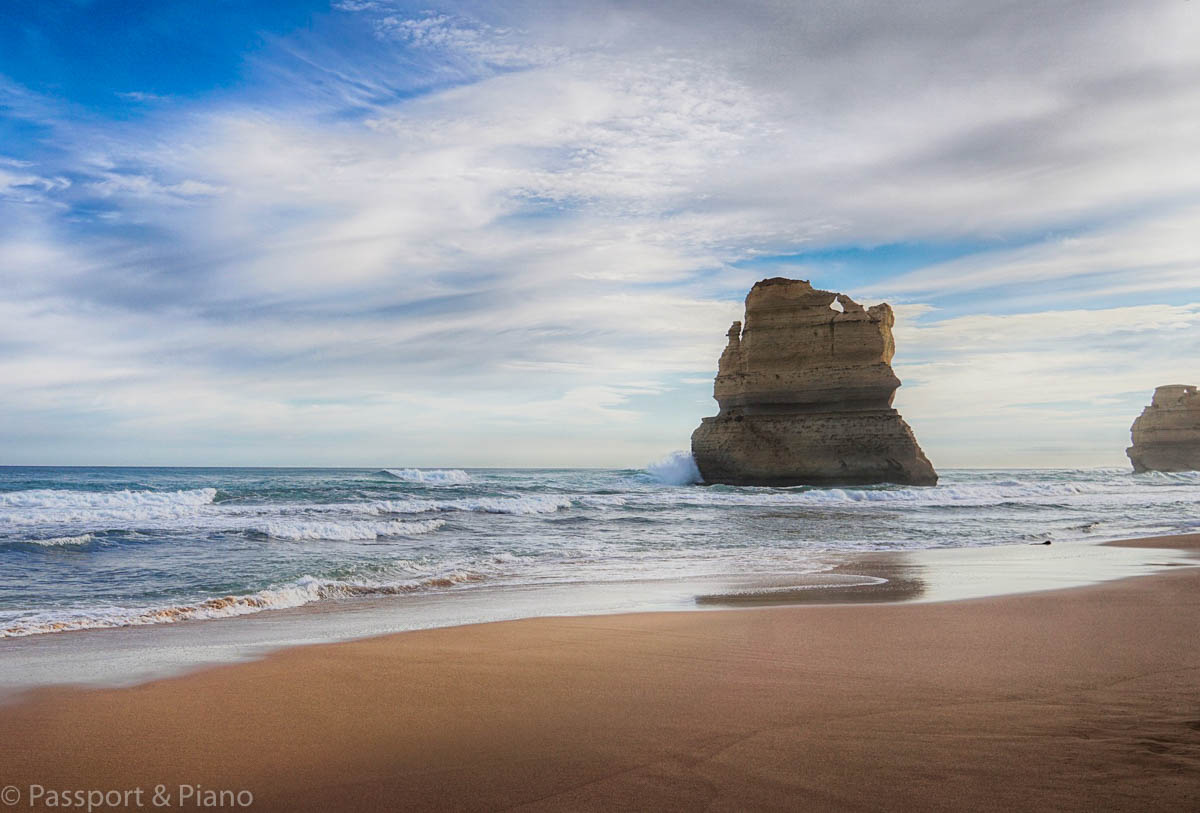
Locals know them as Gog and Magog, and you see them from the viewing platform. However, to get a real perspective of the size of these stacks head down the Gibson steps to the beach (Weather Permitting).
The noise of the waves crashing against the rocks is incredible, and it’s easy to see how the limestone gets eroded. You can take a stroll along the beach but keep a watchful eye on the tides which change quickly here.
Though the water may look tempting, swimming here is inadvisable due to the strong currents.
12 Apostles Great Ocean Road
Only minutes along the way from the Gibson Steps is on of Australias most famous landmarks, the twelve apostles Great Ocean Road. These 8 (once 12) beautiful sea stacks are the most photographed rock sea formations in the world.
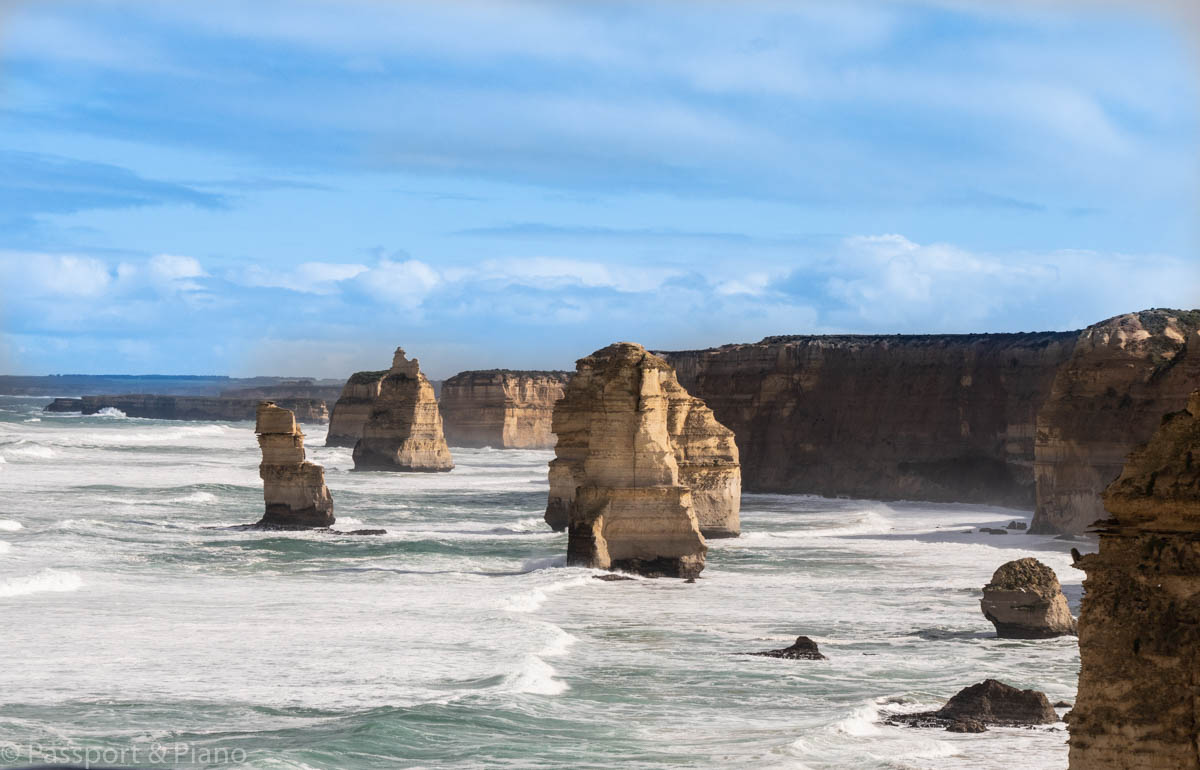
When you first catch sight of them, you’ll see why. Surround by crashing waves and framed by the surrounding limestone cliffs, they look magnificent with the blue sky behind them. The rock formations are a result of constant limestone erosion by the sea.
Layers of shell from marine animals accumulated to form the limestone cliffs millions of years and the powerful waves continually erode the soft minerals. Eventually having bore, caves and arches into the cliff faces sections fall and become sea stacks.
Today there are only eight apostles as the ninth one collapsed in 2005. The erosion is an ongoing natural process, and the rock formations recede by about 2 cm each year. New stacks are likely to form in the not too distant future while the eight remaining apostles may eventually disappear.
Parking is at the visitor’s centre, and there are public toilets here, a cafe and a shop. The wooden walkways down to the viewing platforms are well laid out. It’s best to arrive early or late in the afternoon to avoid the crowds and the Great Ocean Road tour buses.
Set aside plenty of time for your great ocean road apostles stop, you’ll want to take lots of photographs and enjoy what may be a once in a lifetime opportunity.
Helicopter Ride Great Ocean Road
For a unique and exhilarating experience, you can take a Great Ocean Road helicopter flight over the Apostles, London Bridge and the coastline.
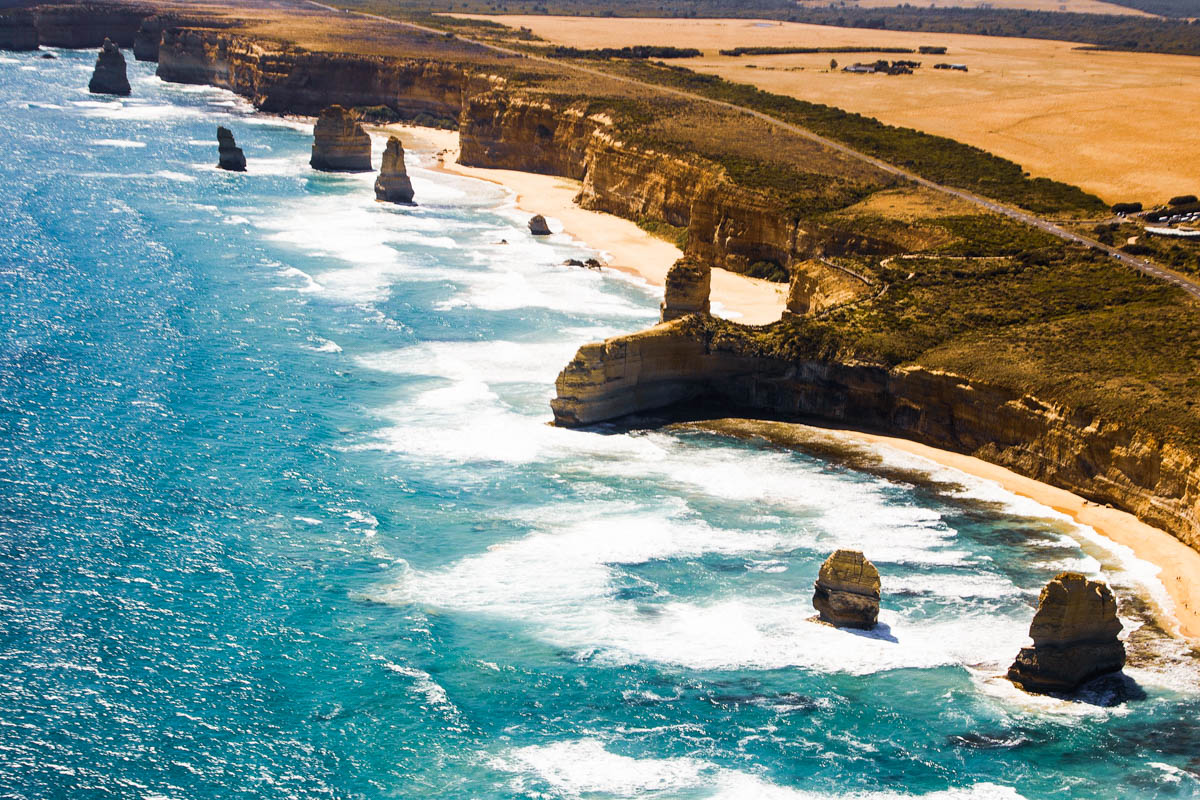
Great Ocean Road Hotels near the 12 Apostles
The best options are in the town of Port Campbell, but if you want to stay close to the 12 Apostles, the Clifton Beach Lodge is an excellent choice. The accommodation here is simple, but the cottages have everything you need for an enjoyable stay.
The cottages are in Princetown just two and a half miles from the Twelve Apostles. They have a seating area with a sofa and a balcony where you can relax with a garden view. The Kitchenette has a refrigerator, microwave, kettle and stovetop, and the bedrooms are spacious with ensuite bath. The downside of staying here is that there is no restaurants or supermarkets within walking distance.
If you prefer to be closer to local amenities, the Portside Motel is an excellent choice. It’s only a 5-minute drive to the 12 Apostles and being in the heart of Port Campbell. There’s a supermarket and a few places to eat within walking distance.
Loch Ard Gorge
Carrying on with the Great Ocean Road Drive about 5 minutes down the road is Loch Ard Gorge. Here is one of the most beautiful Great Ocean Road beaches. Its surrounded almost by the George which since 2009 has separated into two separate pieces of land.
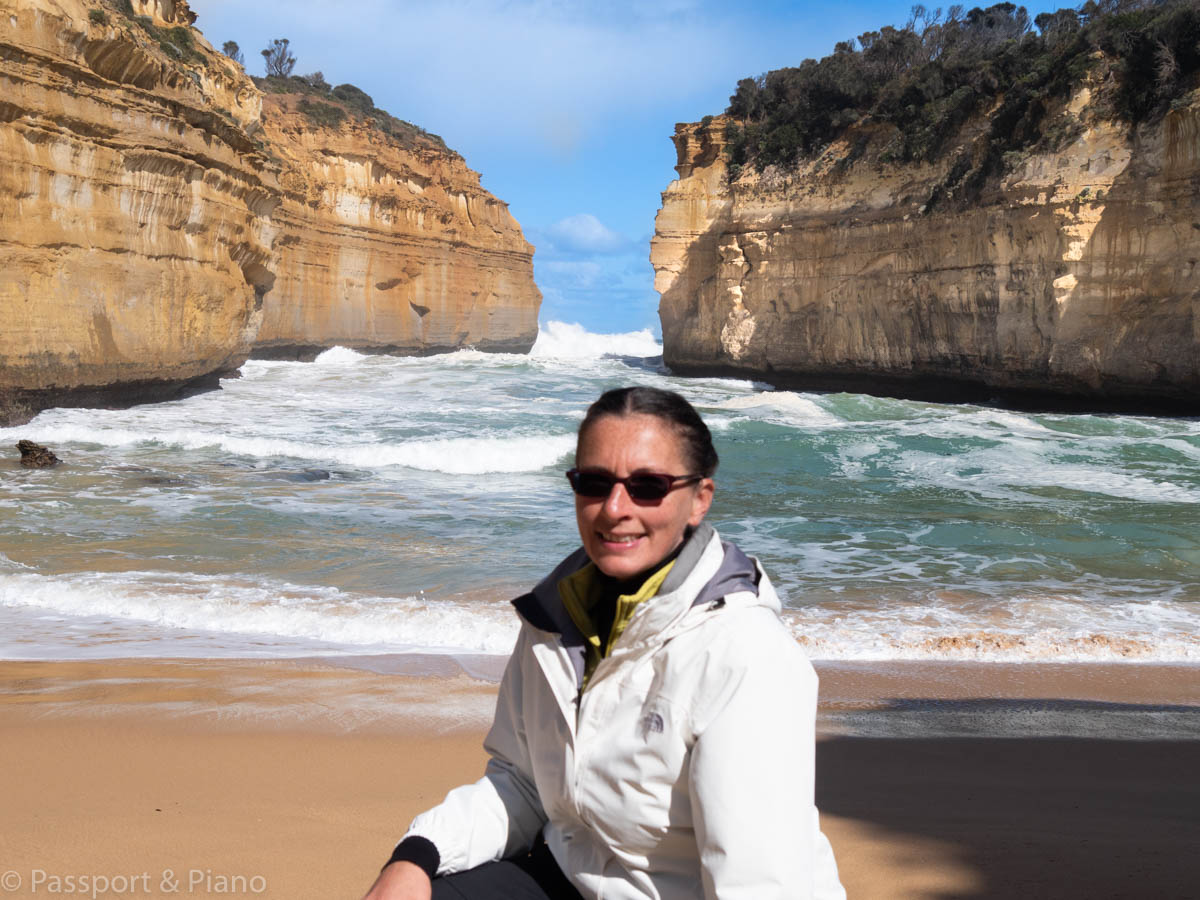
Watching the water come crashing over between the two rocks is fascinating, and I’m sure over time this almost enclosed beach cove will open out further. To get to the beach, you have to take the steps down from the car park.
If you walk by the water, you can expect to get wet as the waves suddenly crash and flood the shore from nowhere. If you time your visit right and avoid the tourist buses, it is possible to have this gorgeous cove all to yourself.
The Gorge takes its name from the famous ship Loch Ard that came into difficulty near Mutton Island, Port Campell. Of the 54 people on board, there were only two survivors.
There are three walks that you can take from the car park along the rugged edge of the cliff tops. To walk all three of them takes 2-3 hours, but if you complete them, you’ll reap the rewards of spectacular views over Loch Ard Gorge and Mutton Bird Island.
The walks are well signposted, and there are information boards along the way which reveal fascinating facts and stories about the history and geology of the area.
Wreck of Loch Ard
Distance 1.4km Time: 50 Minutes
Discover the tragic story of the Loch Ard Shipwreck on this easy walk to the cemetery
Geology 900m return 40 minutes.
Learn about the natural forces of nature that have created this magnificent coastline on this short and easy walk.
Living on the Edge
Distance 3.2 km allow 90 Minutes.
This is a longer walk along the edge of the cliff tops from which you can see the Mutton Bird Island. The trail is easy and takes in the stunning blowhole Thunder Cave and Broken Head.
Port Campell
Port Campbell is a small town but a popular one due to its proximity to the number of places to visit Great Ocean Road. The bay is surrounded by magnificent limestone cliffs, and there are dramatic vistas to admire.
It’s also one of the few places that you can swim in the sea safely. The town has some great accommodation options and a few good restaurants.
Accommodation in Port Campbell
There’s a wide variety of houses to rent in Portcampbell, but the Portside Motel is an excellent choice.
Port Campell to Warrnambool
There are more fantastic rock stacks to stop and admire on this section of the Great Ocean Road drive.
Arch
The arch is 6km west of Port Campbell and is a beautifully curved shape rock formation that juts out from the bottom of the cliffs.

It’s not as impressive as the London Bridge further along the way, but it’s well worth stopping for if you have the time.
From the viewing platform, you can look back and see the 12 apostles in the distance and be mesmerised by the way the water crashes through the arch.
London Bridge
You’ll often hear people refer to the London Bridge as the arch since the bridge is no longer. Up to 1990, you could walk across from the mainland to the enormous rock formation, but the erosion caused it to collapse. The event was dramatic and left two tourists stranded on the rocks and needed a helicopter to rescue them.
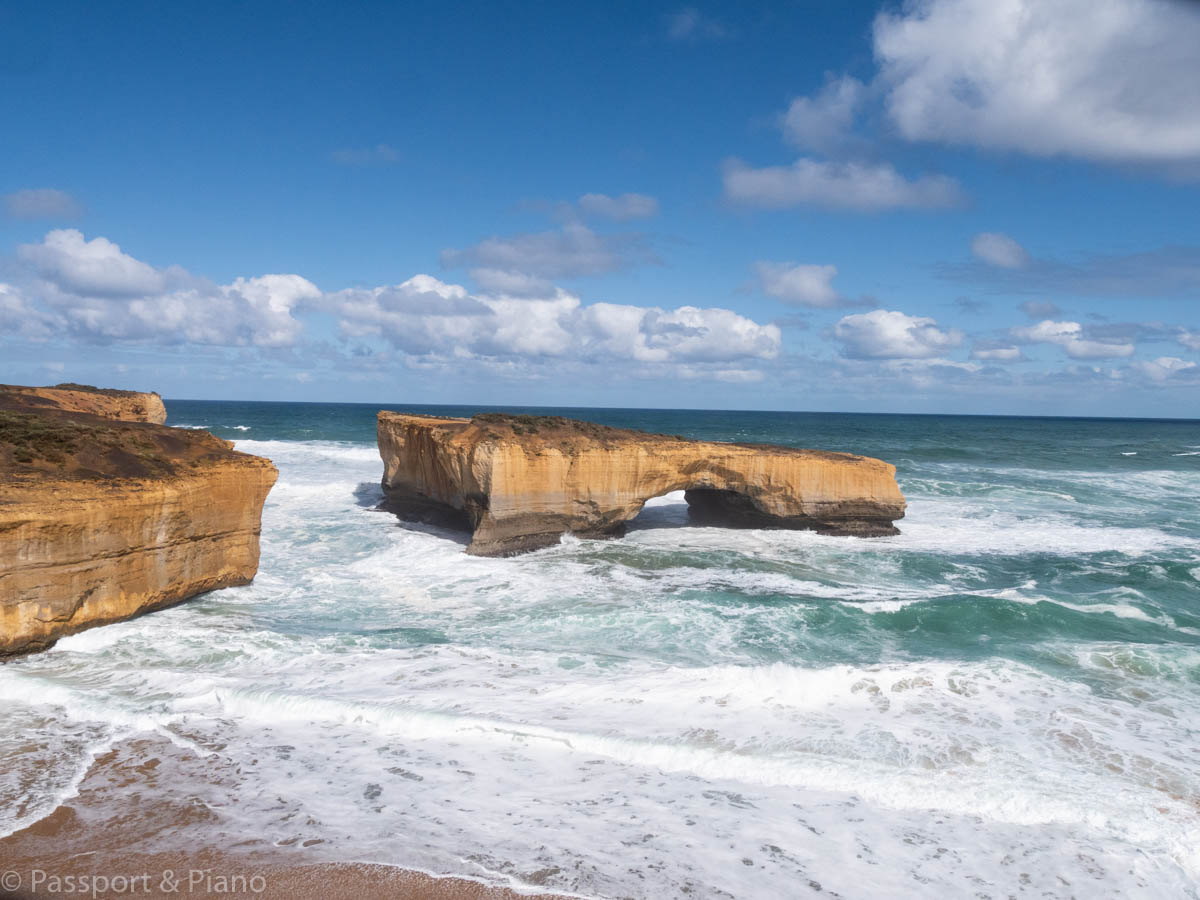
There are two viewing platforms on different levels, and the view is breathtaking. The London Bridge is the largest of the sea stacks, and the water crashes through the arch below with incredible force.
The Grotto
A short drive further along the route is one of the hidden gems of the Great Ocean Road sites. The Grotto is a sinkhole, but it perhaps has one of the most picturesque views of all along this famous Great Coast Road.
The Grotto has a blowhole which creates memorising spays of water, and the view through the hole is stunning and looks outwards towards the ocean.
The shadows cast over the water turn the sea into an array of colours ranging from green, through to turquoise and then bright blue.
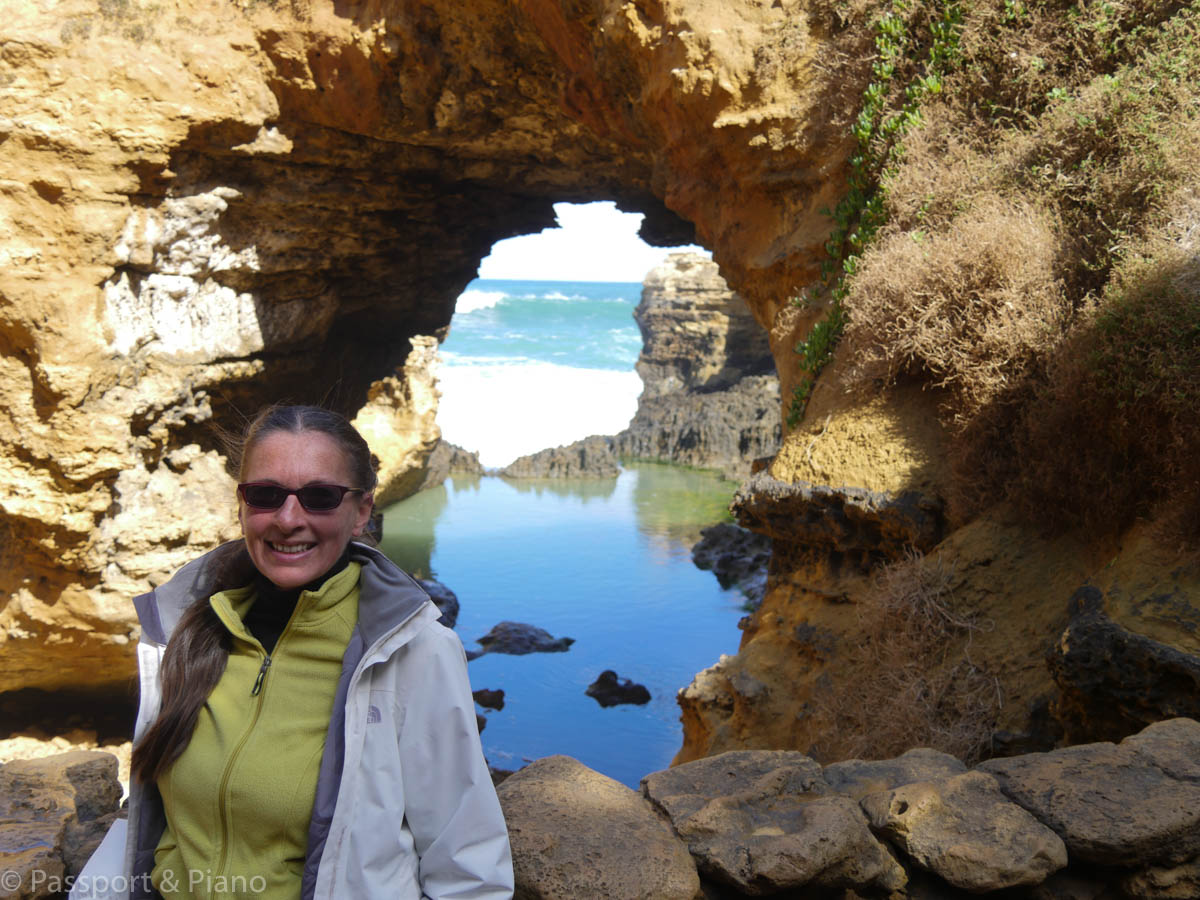
You have to descend some steps to get the best views of the Grotto, and the viewing area is small but enchanting. Surrounded by the limestone rock, little rock pools and vegetation growing from the cliffs it’s beautiful. The best time to visit is at sunrise or sunset when the rays cast by the sun turn the rock into vivid shades of red.
Warrnambool
If you are planning a Great Ocean Road trip itinerary in July, August and September Warrnambool is a great place to watch the whales on their migration route.
There’s a whale watching platform and its possible although not guaranteed that the Southern Right Whales Breaching and their tail slapping will entertain you off the platform.
The information centre close by will tell you if there have been any sightings.
For guaranteed sightings of Whales have a read of this guide to the whale watching Hervey Bay Season in Queensland.
If you don’t fancy driving back to Melbourne when you reach Warrnambool, the Comfort Inn, the International Warrnambool offers excellent accommodation at an affordable price.
Just a short walk from the train station in Warrnambool the Comfort Inn offers ensuite rooms, which include a refrigerator, a toaster and tea and coffee making facilities. The rooms are spacious, and everyone has a seating area with a sofa.
Things to consider when planning your Great Ocean Road Itinerary?
How much driving do you want to do along the Great Ocean Road route each day?
While a Great Ocean road trip is possible in one day, you may wish to consider making a weekend of it, especially when you’ve read through this Great Ocean drive itinerary.
If you are short on time, consider driving straight to and stay overnight, then drive gradually back to Melbourne the next day, taking in the major sites along the way.
How much time do you want to spend at the Great Ocean Road Sights
Some people are happy to park the car take a quick look and drive on, while other travellers like to take there time and see everything there is to see.
There is no right or wrong, but plan your Great Ocean Road around your needs, be realistic and that way you won’t be disappointed.
How long is the Great Ocean Road?
The Great Ocean Road Australia is 243km long between its starting point in Torquay to and the endpoint in Allansford. The distance from Melbourne CBD to the start of the road is 103km.
Travelling the Great Ocean Road is a fantastic experience, take your time, soak up the vista’s, it may be a once in a lifetime opportunity, so make the most of your visit.
Happy travelling and I hope you’ve found this guide helpful in planning your Great Ocean Road Itinerary. If you’re visiting Melbourne you may be interested in reading my Melbourne 5 days itinerary.
Passport and Piano is a participant in the Amazon Services LLC Associates Program, an affiliate advertising program designed to provide a means for sites to earn advertising fees by advertising and linking to amazon.com, amazon.co.uk, amazon.ca. Amazon and the Amazon logo are trademarks of Amazon.com, Inc. or its affiliates.




